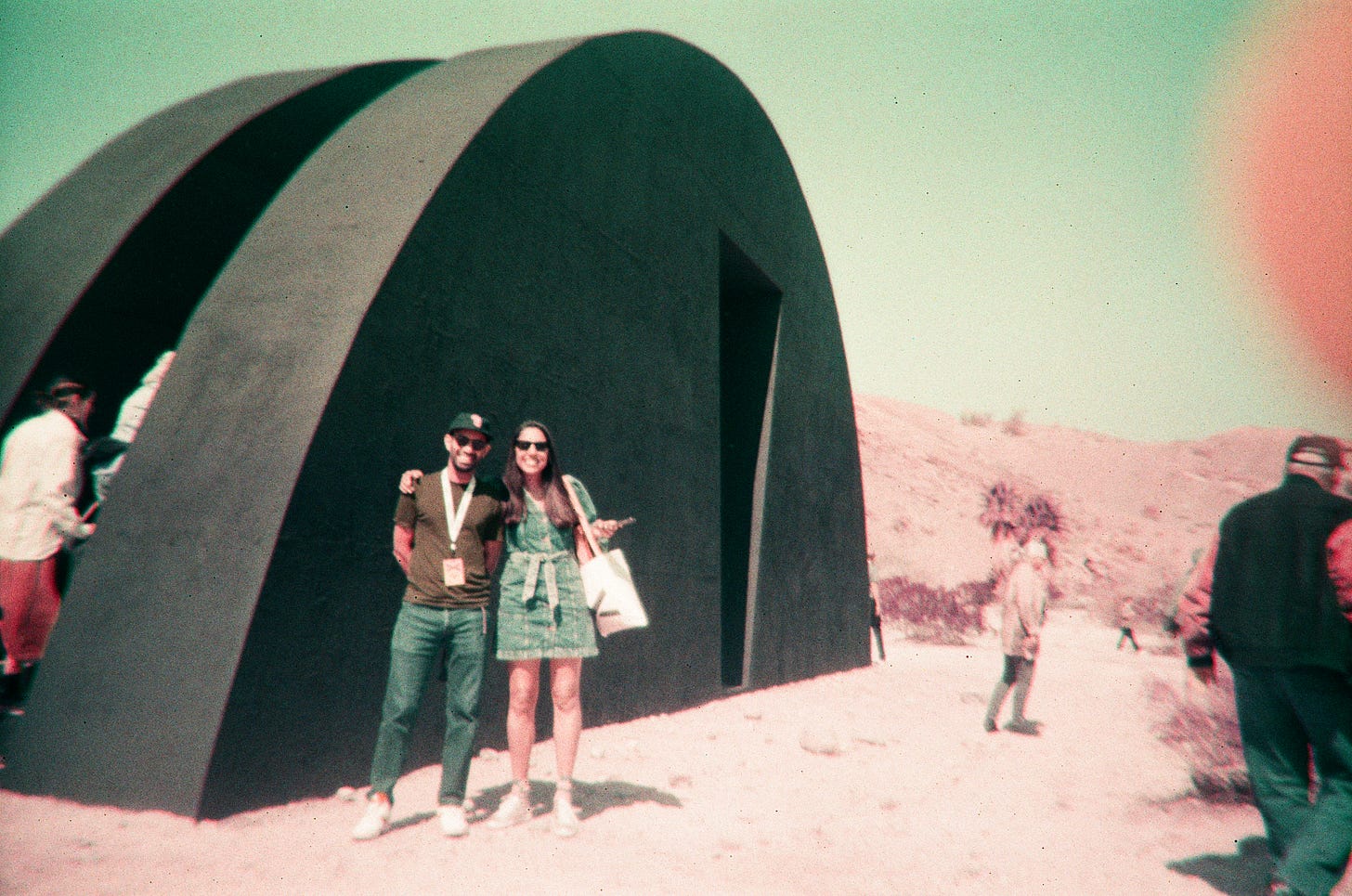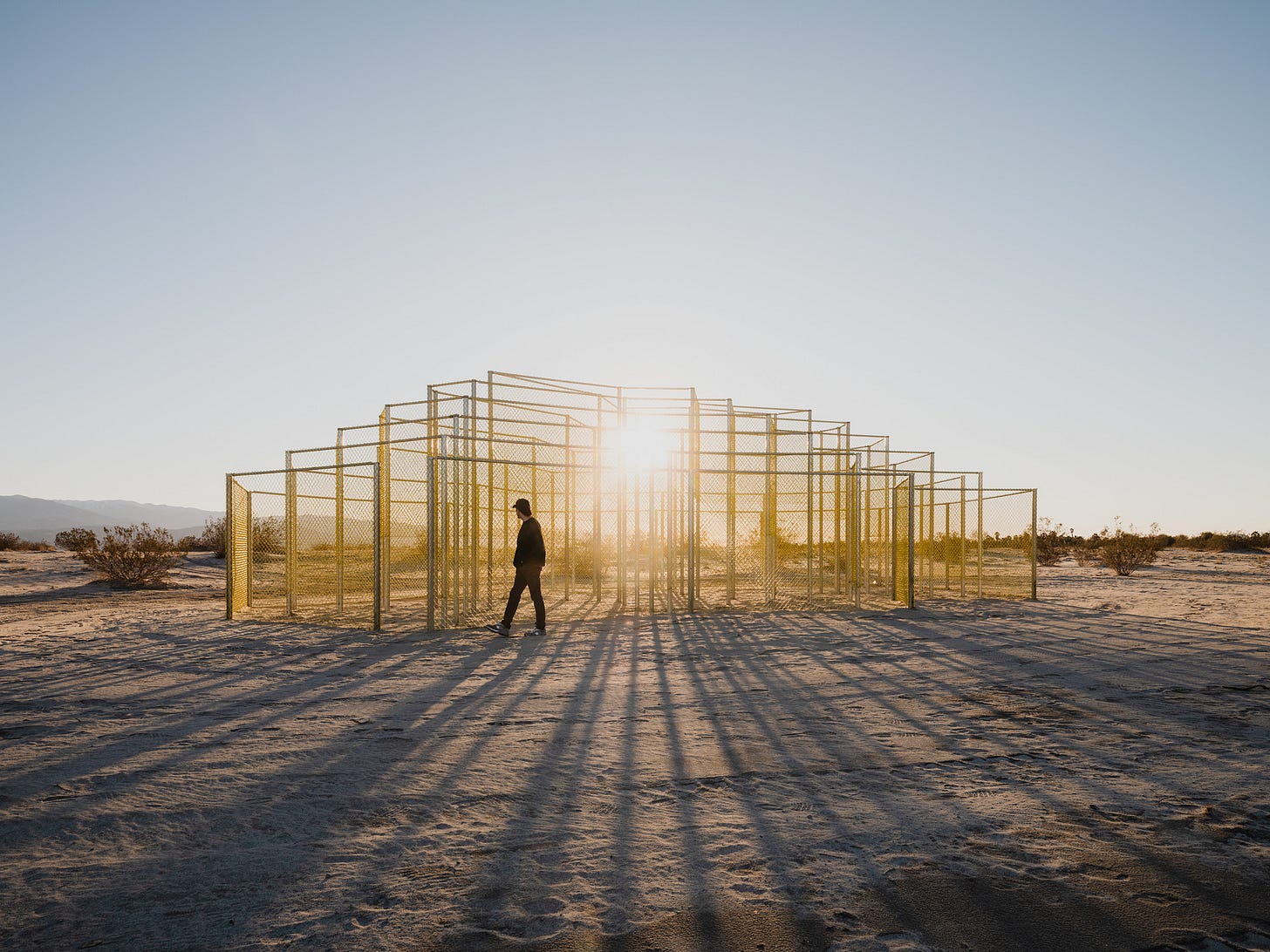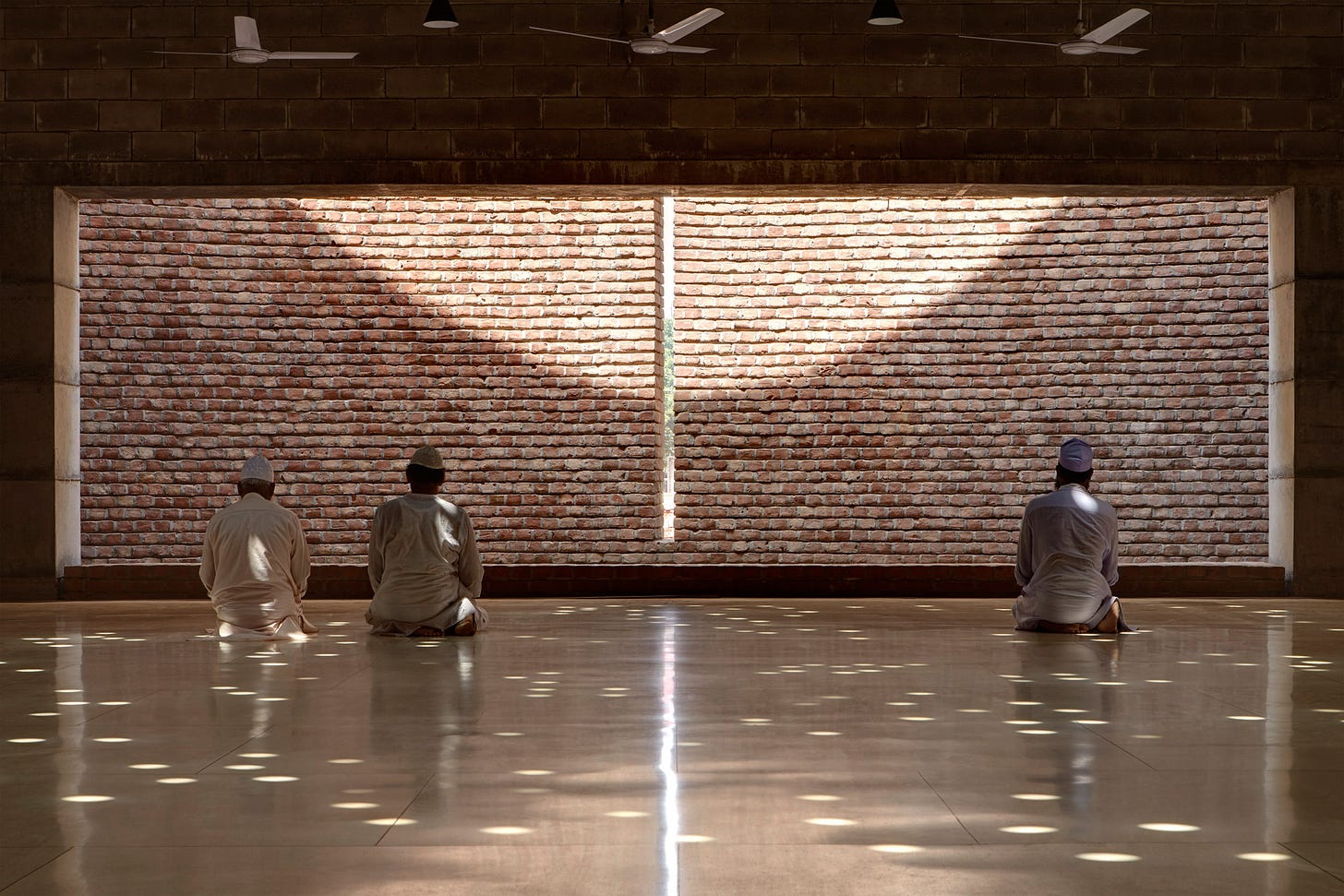How SoCal’s Desert X is passing the paintbrush to the women of Bangladesh
Outdoor art extravaganza Desert X is the current destination du jour in the Southern Californian art scene and this year it is uniquely powered by women with varying links to… Bangladesh?
“My parents are from Bangladesh.”
“Oh, is that in India?”
This is an exchange I’ve had more times than I can count.
Bangladesh is a country. It’s the 8th most populous country in the world, ahead of Russia and Mexico. The region of Little Bangladesh in Los Angeles sits in a four-block pocket inside of Koreatown, comparable in size to Historic Filipinotown, but maybe not in status. Over 80% of “Indian” restaurants in the UK are owned and run by Bangladeshi people, most often cooking the UK’s national dish of chicken tikka masala.
But sometimes, with some people, it’s just easier to say, “Yeah. It’s in India.”
Bangladesh accepted its plucky underdog status long ago. It was curious and exciting, then, to see the 2023 edition of Desert X - a popular outdoor art biennale in Palm Springs, California that started in 2017 - boasting input from three women with strong links to Bangladesh.

This year’s event was curated by Diana Campbell, a California native who immigrated to South Asia a decade ago, and the show features British-Bangladeshi artist Rana Begum, and Bangladeshi architect Marina Tabassum.
Campbell’s work with the Dhaka Art Summit is paramount to these links. The parallels with Desert X are strong and frequent.
With 572,000 visitors over 9 days, February 2023’s Dhaka Art Summit became the highest daily visited art show in the world. Let that sink in for a moment. Yes, there is the context of Dhaka being the 6th most densely populated city in the world, but that’s still a lot of people. For context, the 2021 edition of Desert X welcomed 650,000 visitors over two months. Los Angeles - the nearest conurbation - is no slouch when it comes to population, either.
Campbell speaks fluently to the reasons why Desert X saw the way she works as the best fit for them.
“The Dhaka Art Summit is for first-time art visitors, a lot of youth and international museum directors. We’re speaking to the most educated and critical people in the art world and the first-time public with the same material. It’s a place where artworks are new and we’re also working in a climate extreme environment.”
“It’s not just an art show. You can see how it’s actually changing people’s lives. Being able to be creative and express yourself, it gives people agency and for a young country like Bangladesh, people need to imagine new careers and new forms of jobs, new businesses.”
“That’s what I’m hoping Desert X does. Here, you don’t have to go into a museum to encounter the artworks. They’re in a public space that’s free. Suddenly you’re going to see something in the landscape that makes you think differently. In the wake of Trump and America First, it was really important for me to have artworks from other parts of the world to show how interconnected we all are.”

Indeed, the art and the dozen artists on show at Desert X are as diverse as one could hope. Aside from the two with Bangladeshi links we talk about in this piece, one is a local Cahuilla Indian artist (providing a fantastic, thought-provoking, interactive exhibit about our knowledge of the indigenous people of the Coachella Valley), a majority are women, and three are from Mexico, including Hector Zamora whose performance piece in Bangladesh featured clay pots that Bangladeshi women came in and smashed with their feet.
“Most of the artists [at Dhaka Art Summit] are Bangladeshi and the foreign artists focus on Bangladesh, so it chips away at some of the insecurity that colonialism can bring in, making you think that something from somewhere else is better.”
Campbell is effusive when talking about art in Bangladesh, both in terms of potential and in terms of what is already happening there.
“People associate [Bangladesh] with tremendous challenges but I’m seeing incredible works of art arising because people have this creative will to do something. It’s not driven by a market or a scarcity mindset. It’s driven by a mindset that there’s an abundance of creativity and you can do something with that.”
Those challenges are still evident and incredibly visible, however. Rana Begum also sees how the work being done in Bangladesh is having a big effect.
“The massive difference between the poor and the rich [in Bangladesh] can be quite traumatic. I remember thinking about my cousins struggling to have an education. The opportunities were very limited for Bangladeshi artists, so I feel that what Diana and the Samdani Foundation are doing, creating a platform for Bangladeshi artists to have dialogues with international artists and curators is incredible.”
Projects from the Dhaka Art Summit have found their way into museums such as MoMA, the Tate and the Met. The work being done has had some real, tangible results and it’s being powered by the Samdani Art Foundation - a private arts foundation spearheaded by Nadia Samdani MBE and her husband Rajib with a noble and currently successful mission of connecting Bangladesh to the rest of the world via art.

Bringing Bangladeshi art to the world in a different way - via status - is Marina Tabassum. A renowned architect, she won an Aga Khan Award for Architecture in 2016 for the beautiful, perforated brick Baitur Rauf Mosque (no relation). In 2021, the New York Times listed it as one of The 25 Most Significant Works of Postwar Architecture.
Tabassum’s work, however, can not be found on display in the Palm Desert. Indeed, her work can’t be found in any country but Bangladesh. In an opposite action to the Brain Drain, where educated people emigrate from lesser developed countries in pursuit of a better life, Tabassum sees it simply: that there is so much good work to be done in Bangladesh. While she continues to teach and exhibit all over the world, for her it’s about empowering more female architects at home.
That is evident in the film that Desert X commissioned of her idea - a $500 home called the Khudi Bari (Bangla for “tiny house”). They were designed for the poorest, who live in ever-changing micro-desert islands in the middle of vast river channels that are constantly at risk of rapid erosion during flash flooding. The small, rebuildable homes are evidence of a fascinating and innovative solution that is already in use.
Consider the Case Study Houses of Los Angeles - the post-war project to design a series of affordable, replicable houses for families. The Khudi Bari concept has the same sentiment coursing through it, though maybe for people living in a rather less stable environment.
If the thought is crossing your mind that a $500 house could be a perfect solution for the seemingly unsolvable problem of homelessness in America, I’m afraid the reason Marina Tabassum’s bold and inspirational work for Desert X is confined to the internet is because it would have cost $50,000 to build a Khudi Bari in California.
A segue from housing in extreme conditions into citizenship and maybe a little back into cages at borders and whatnot (people just trying to remain alive) is to Rana Begum’s work.
Having previously worked with Cornish fishermen’s nets during her residency at Tate St. Ives and then translating that to Bangladeshi fishing nets when showing in Dhaka, for Desert X Rana Begum uses a material ubiquitous not just to Southern California, but all around the world: chain link fence.
“It has this negative connection to it, which is people putting up fencing and walls to stop people going to places… But it’s incredibly beautiful, which is in contrast to what it means as a material.”
“I wanted to use something that people take for granted but don’t really see the aesthetic quality. I’m hoping that it’ll make people think about what it’s for and look at their surroundings and think about them.”

Campbell talks lovingly of Rana Begum’s large-scale artworks, which use light, color and commonly-occurring materials to provoke.
“A female sculptor working at that scale? There are very few. Big sculpture is a very male-oriented field and Rana has really been pushing that.”
When pressed on the topic, Begum speaks to a situation that will resonate with so many when it comes to parental pressure in education.
“I grew up in a family that didn’t really want me to do art. It takes a lot of resistance to not be pressured into going away from what you want to do. It’s even harder in places like Bangladesh to have opportunities. I’m in awe of the strength that women are able to show - and it takes a lot of strength.”
That they’re all women is neither coincidence nor any sort of equal opportunity virtue signalling. While it’s clear that social, or even global equity is high on Desert X’s list of intentions, Bangladesh has its own long history of empowering women. Let it be lifting women out of poverty via work in the garment factories (imagine paying them over $80 a month) or that current Prime Minister Sheikh Hasina is the world's longest-serving female Head of Government in history.
While Bangladesh is three places above the USA in the Global Gender Gap Index 2020 Rankings, the $192 billion gender gap in the art world is not going to be addressed completely by any one event. Talking about it and highlighting those who are forcing progress is the conversation that you and I are having right now.
So is it still reasonable to say that Bangladesh is something of an outsider in the global art scene? Absolutely, but with Campbell’s work with the Dhaka Art Summit and the Samdani Foundation casting influence on and exporting talent to top museums and high-visibility events such as Desert X, that might appear to be changing.
That influence might, at least, be enough to put Bangladesh on the map.
My favorite moments at Desert X
Gerald Clarke - Immersion
Via the clever Trivial Pursuit-style card game that accompanies this giant maze, I discovered that institutional bias in education might not put Californians ahead of this Englishman in terms of understanding indigenous populations.
Rana Begum - No. 1225 Chainlink
Another giant maze that has [spoiler redacted]. The changing light and shadows are incredibly interesting visually from both inside and outside the work. It’s always a personal highlight to be inside art.
Hylozoic/Desires - Namak Nazar
A deep and complex study of salt and all its connotations using sound, the natural environment and historical messaging. Name something (physical or beyond) that salt does not touch. Fascinating stuff.
Desert X is on show in the Coachella Valley, CA until May 7th, 2023.
Have you already been to Desert X, or are you planning to go? Seen one of the artists elsewhere? Just like art and want to talk? A fellow Bengali? Leave your comment below.




No. 1225 Chainlink looks astonishing. I’m jealous.
Wonderful write up 👍
I’ve an invitation for you: Please come to Dhaka for next Dhaka Lit Fair. You will have a lifetime experience 😊